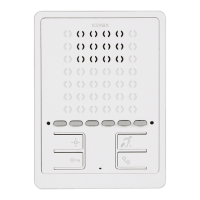11
GB
Fig. 2.2
F During normal operation:
- Flashing light: indicates that the interphone is receiving
a call (from outdoor entrance panel or from an intercom-
municating device).
- Steady light: ringtone muted.
- Steady light flashing every 10s: if calls have been
made from the entrance panel while the ringtone was
muted, the LED flashes a number of times equal to the
number of calls received from the entrance panel (up to
4 calls are memorised). The flash log is reset when the
ringtone volume is restored.
During programming:
- Flashing light: indicates programming mode.
G During normal operation:
- Steady light: indicates that the door is open if the sen-
sor has been installed on at least one entrance panel
and connected between terminals PA and M.
During adjustment:
- Flashing light: indicates that ringtone selection or vo-
lume adjustment is in progress.
Signals:
Connection terminal block:
1, 2 Two pairs of terminals for Two-Wire bus
E+, E- Additional power supply for monitor with power supply unit type
6923.
12V Connection of additional chime (positive reference 12V).
CH Connection of additional chime (call repetition).
FP Input for door call button (with reference to terminal M).
M Earth reference.
Connection terminal block
Operation
Important: For the interphone to work, the ID must have already been pro-
grammed. To check this, press any of the interphone buttons. If an ID has
been assigned to the interphone, a beep will sound when a button is pres-
sed; if no ID has been assigned or it has been deleted, a triple beep will
sound.
Operating times
The answer and conversation times depend on the configuration of the
corresponding entrance panel parameters (to change these times, please
refer to the electronic entrance panel unit instructions).
- Answer time (for entrance panel call): Default value 30 s
(minimum value 1 s, maximum value 255 s)
- Answer time (for intercommunicating call): 30 s (fixed value)
- Conversation time (for entrance panel call): Default value 120 s
(minimum value 10 s, maximum value 2550 s)
- Conversation time (for intercommunicating call): Default value 5 minu-
tes (can be modified to unlimited time).
Answering a call
A call from the outdoor entrance panel or from an intercommunicating de-
vice can be answered during the chime cycle or once it has ended. To an-
swer, lift the handset; to end the call, replace the handset.
Receiving a door call
The interphone can receive calls from a door call button if connected to
terminals M and FP directly or via interface 6120 (see wiring versions).
When the door call button is pressed, the interphone emits a different tone
to the one used for outdoor entrance panel calls or intercommunicating
calls. To stop the chime, lift the handset.
In the case of a door call by means of a button connected directly to the
interphone’s terminals FP and M; chime cycle duration depends on how
long the button was held down (max. 10 s).
Making an intercommunicating call
To make a call to another indoor unit, one or more buttons must have been
programmed (see “Button programming” section).
To make the call, press the button programmed for the relevant indoor unit.
During the call, the interphone emits a tone in order to signal that the call
is being made. If the interphone/monitor is already engaged in another call,
a tone will be heard on the interphone making the call to indicate that the
user receiving the call is busy.
When the indoor unit receiving the call answers, communication begins
automatically. Replace the handset to end the conversation.
The maximum conversation time is 5 minutes (default).
Muting the ringtone during a call (Mute function)
When receiving a call from an outdoor entrance panel or from an intercom-
municating device or a door call via device 6120, the call ringtone can be
muted by pressing button B.
Door lock command
Press the lock button (with the handset hooked on or in conversation) to
send a lock opening command to the entrance panel (by default, the last
entrance panel to make a call).
Self-start
- Self-start with dedicated button (button A):
to use the self-start function and communicate with the master entrance
panel, lift the handset and briefly press button A (self-start) and lift the
handset to start the conversation. Replace the handset to end the con-
versation.
- Self-start with programmed button to a specific panel:
to use the self-start function and communicate with a specific entrance
panel, lift the handset and press and release the button programmed to
call that entrance panel (see “Programming the self-activation/self-start
button to a specific panel ” section).
Calling a porter switchboard
To call a porter switchboard (if present in the system): lift the handset and
press button C (lock) to make the call.

